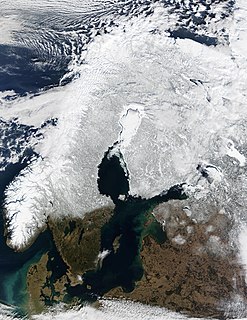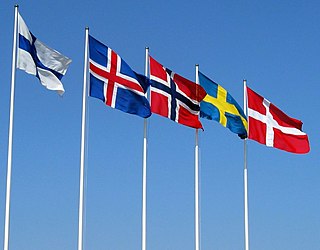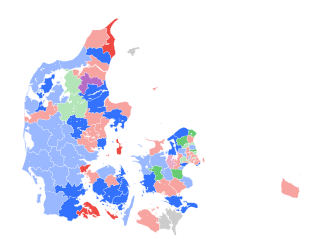
Bornholm is a Danish island in the Baltic Sea, to the east of the rest of Denmark, south of Sweden, northeast of Germany and north of Poland. Occupying an area of 588.36 square kilometres (227.17 sq mi), the island had a total population of 39,535 on 1 April 2022.

Scandinavia is a subregion in Northern Europe, with strong historical, cultural, and linguistic ties between its constituent peoples. In English usage, Scandinavia most commonly refers to Denmark, Norway, and Sweden. It can sometimes also refer more narrowly to the Scandinavian Peninsula, or more broadly to include Finland, Iceland, and the Faroe Islands.

Denmark is a Nordic country in Northern Europe. It is the most populous and politically central constituent of the Kingdom of Denmark, a constitutionally unitary state that includes the autonomous territories of the Faroe Islands and Greenland in the North Atlantic Ocean. European Denmark is the southernmost of the Scandinavian countries, lying southwest of Sweden, south of Norway, and north of Germany.
Home rule is government of a colony, dependent country, or region by its own citizens. It is thus the power of a part of a state or an external dependent country to exercise such of the state's powers of governance within its own administrative area that have been decentralized to it by the central government.

Skåneland or Skånelandene (Danish) is a region on the southern Scandinavian peninsula. It includes the Swedish provinces of Blekinge, Halland, and Scania. The Danish island of Bornholm is sometimes also included. Skåneland has no official recognition or function and the term is not in common usage. Equivalent terms in English and Latin are "the Scanian provinces" and "Terrae Scaniae" respectively. The term is mostly used in historical contexts and not in daily speech. In Danish, Skånelandene is used more often. The terms have no political implications as the region is not a political entity but a cultural region, without officially established administrative borders.

The Treaty of Roskilde (NS) during the Second Northern War between Frederick III of Denmark–Norway and Karl X Gustav of Sweden in the Danish city of Roskilde. After a devastating defeat, Denmark–Norway was forced to give up a third of its territory to save the rest, the ceded lands comprising Blekinge, Bornholm, Bohuslän (Båhuslen), Scania (Skåne) and Trøndelag, as well as her claims to Halland.

Scanian is an East Scandinavian dialect spoken in the province of Scania in southern Sweden. Present-day speakers of "Scanian" speak the Scanian dialect of Swedish. Older Scanian formed part of the old Scandinavian dialect continuum and are by most historical linguists considered to be an East Danish dialect group, but due to the modern-era influence from Standard Swedish in the region and because traditional dialectology in the Scandinavian countries normally has not considered isoglosses that cut across state borders, the Scanian dialects have normally been treated as a South Swedish dialect group in Swedish dialect research. However, many of the early Scandinavian linguists, including Adolf Noreen and G. Sjöstedt, classified it as "South Scandinavian", and some linguists, such as Elias Wessén, also considered Old Scanian a separate language, classified apart from both Old Danish and Old Swedish.

A Nordic cross flag is a flag bearing the design of the Nordic or Scandinavian cross, a cross symbol in a rectangular field, with the centre of the cross shifted towards the hoist.
The Treaty of Copenhagen was signed on 27 May 1660, and marked the conclusion of the Second Northern War between the Swedish Empire and the alliance of Denmark-Norway and the Polish–Lithuanian Commonwealth. This treaty was a smaller follow-up treaty to that of the Treaty of Roskilde, which decisively delineated the mutually recognized boundaries of Denmark, Sweden, and Norway; boundaries which are almost exactly the same to this day.

The five Regions of Denmark were created as administrative entities at a level above the municipalities and below the central government in the public sector as part of the 2007 Danish Municipal Reform, when the 13 counties (amter) were abolished. At the same time, the number of municipalities (kommuner) was cut from 270 to 98. The reform was approved and made into a law by the lawmakers in the Folketing 26 June 2005 with elections to the 98 municipalities and 5 regions being held Tuesday 15 November 2005.
Bornholmsk is an East Danish dialect spoken on the island of Bornholm in the Baltic Sea. It was originally part of the East Danish dialect continuum, which includes the dialects of southern Sweden, but became isolated in the Danish dialect landscape after 1658, when Sweden annexed the eastern Danish provinces of Scania/ Skåne, Halland and Blekinge.

The Danish Realm, officially the Kingdom of Denmark, is a sovereign state located in Northern Europe and Northern America. It consists of metropolitan Denmark, the kingdom's territory in continental Europe and sometimes called "Denmark proper", and the realm's two autonomous countries: the Faroe Islands and Greenland. The relationship between the three parts of the Kingdom is also known as The unity of the Realm.
A non-binding referendum on Greenland's autonomy was held on 25 November 2008 to support or oppose the Greenland Self-Government Act. It was passed with 75% approval and a 72% turnout. The non-binding referendum was on expanded home rule in 30 areas, including police, courts, and the coast guard; gave Greenland a say in foreign policy; provided a more definite split of future oil revenue; and made the Greenlandic language the sole official language.

Scania, also known by its native name of Skåne, is the southernmost of the historical provinces (landskap) of Sweden. Located in the south tip of the geographical region of Götaland, the province is roughly conterminous with Skåne County, created in 1997. Like the other former provinces of Sweden, Scania still features in colloquial speech and in cultural references, and can therefore not be regarded as an archaic concept. Within Scania there are 33 municipalities that are autonomous within the Skåne Regional Council. Scania's largest city, Malmö, is the third-largest city in Sweden, as well as the fifth-largest in Scandinavia.
The Bornholm Tunnel is a proposed railway tunnel which would be built between the island of Bornholm, belonging to Denmark, and Scania in Sweden. The tunnel would provide a fixed link to the island, both using direct trains running from Copenhagen and with a motorail service to transport automobiles. The tunnel would be 40 kilometers (25 mi) long and provide a one-hour transit time for cars, including loading and unloading, and a two-hour service by rail to Copenhagen via the Ystad Line and the Øresund Line. The latter could be further reduced with construction of high-speed rail in southern Scania.

Blekinge is one of the traditional Swedish provinces, situated in the southern coast of the geographic region of Götaland, in southern Sweden. It borders Småland, Scania and the Baltic Sea. It is the country's second-smallest province by area, and the smallest province located on the mainland.
Events from the year 1658 in Denmark.

Greenlandic independence is a political ambition of some political parties, advocacy groups, and individuals of Greenland, an autonomous territory within the Kingdom of Denmark, to become an independent sovereign state.

The Danish local elections of 2013 were held on 19 November 2013 in Denmark's 98 municipal councils, contesting 2,444 seats for the 2014–2017 term of office, and in five regional councils, contesting 205 seats for the 2014–2017 term. Advance voting began on 20 August 2013 in national registration offices in Denmark, hospitals, prisons, etc. Twelve women held the highest political office of mayor in the municipalities in the 2014–2017 term of office.

The Faroese independence movement, or the Faroese national movement, is a political movement which seeks the establishment of the Faroe Islands as a sovereign state outside Denmark. Reasons for complete autonomy include the linguistic and cultural divide between Denmark and the Faroe Islands as well as their lack of proximity to one another; the Faroe Islands are about 990 km from Danish shores.













